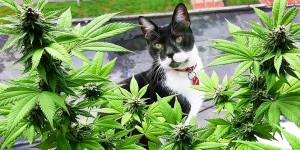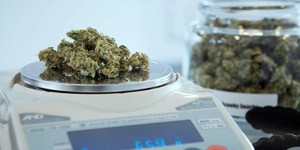By José Carlos Bouso

José Carlos Bouso is a clinical psychologist and a doctor of pharmacology. His areas of interest are psychopharmacology and the therapeutic properties of entactogens, psychedelics and cannabis. He has conducted therapeutic research with MDMA, pharmacological research with several substances of plant and synthetic origin and has also performed studies on the long-term neuropsychological effects of substances such as cannabis, ayahuasca and cocaine. He is author of the book "Qué son las drogas de síntesis" [What are synthetic drugs?], and co-author of “¿La marihuana como medicamento? Los usos médicos y terapéuticos del cannabis y los cannabinoides" [Marihuana as medicine? The medical and therapeutic uses of cannabis and cannabinoids] and "Ayahuasca y salud" [Ayahuasca and health]. His research has been published in scientific journals. He is currently the director of scientific projects at Fundación ICEERS.
Although cannabis has long been considered as a “drug of abuse”, in recent years an increasing number of studies published in the biomedical literature indicate that either the plant itself or some of its compounds may be of use in treating addictions. For example, a recent review sets out the current evidence on the involvement of the endocannabinoid system in modulating addictive behaviour, looking at the results of research with animals on the potential role of some cannabinoids in treating psychostimulant addiction1. More specifically, there is evidence to indicate that pharmaceuticals that are CB2 receptor agonists may be of use in treating cocaine addiction2. Certain observational studies have also been published showing that cannabis may be a substitute for more dangerous drugs, including alcohol3. Finally, another recent review compiled current studies focusing on the possible properties of CBD (cannabidiol) as an intervention for addictive disorders4. This article will review the current evidence for considering cannabis in general, and CBD in particular, as a possible aid for quitting smoking.
Tobacco in figures
According to a report published in 2014 by the World Health Organisation (WHO)5, tobacco smoke contains more than 7,000 chemical substances, of which at least 250 are known to be harmful for health and at least 69 are known to cause cancer. According to this report, the spectrum of medical problems that can be caused by smoking include: shortness of breath, exacerbated asthma, respiratory infections, cancer (larynx, oropharynx, oesophagus, trachea, bronchus, lung, acute myeloid leukaemia, stomach, pancreas, kidney, ureter, colon, cervix, and bladder), coronary heart disease, heart attacks, stroke, chronic obstructive pulmonary disease, osteoporosis, blindness, cataracts, periodontitis, aortic aneurysm, atherosclerotic peripheral vascular disease, hip fractures, infertility and impotence.
According to another WHO study, tobacco continues to be the principal preventable cause of death in the world, killing approximately 6 million people each year and causing economic losses estimated at over half a trillion dollars6. The latest report of the Global Tobacco Surveillance System, which gathers data from 22 countries representing nearly 60% of the world's population, shows that there are approximately 1,300 million smokers in those countries, of whom 205 million had made some attempt to quit smoking in the last 12 months7. According to the American Cancer Society, only 4-7% of people are capable of giving up smoking in any given attempt without medicines or other help while around 25% of smokers using medication manage to stay smoke-free for over 6 months. Psychological counselling and other types of emotional support can boost success rates higher than medicines alone8.
Nicotine addiction or tobacco habit?
Although the accepted theory on drug addiction appears to be that it is a chronic, often relapsing brain disease that causes compulsive drug seeking and use, causing a deterioration in control of consumption despite harmful consequences to the addicted individual and to those around him or her9, an ever larger number of experts are beginning to challenge this view of addiction as a brain disease10. At least two studies have found that the percentage of people who recover from their addiction throughout their lives is, in nearly all cases, over 80%11. The results of these studies also indicate that tobacco addiction is the one of the forms of addiction with the lowest cessation rates.
One of these reasons may be the extent to which conventional wisdom in our society ascribes tobacco addiction to the pharmacological effects of nicotine. If attributing addiction to the substance used is a problem for understanding drug addiction in general, in the case of tobacco addiction it becomes especially paradigmatic. The problem with drug addiction in general, and tobacco addiction in particular, is, as we have explained, the problem tends to be attributed to a disorder of the brain caused by a pharmacological agent, when at the base of all addictive behaviour, what is actually introduced is a habit. And this habit is established, not so much by the effects of the substance itself, as by the behaviours involved in seeking and consuming the substance. And it is these habits, as forms of conduct, that are difficult to correct. Indeed, in the specific case of nicotine it is very difficult to train animal models to be addicted to the substance. And as we have seen, the rates of tobacco cessation by pharmacological means (including patches, gum and any other nicotine-based pharmaceutical preparation) are distressingly low12. Therefore, of all the reasons for which tobacco proves addictive for so many people, the fact that it contains nicotine is probably the least significant. It is precisely the fact that it is a habit, which is generally established over a long time –in most cases over several years– that makes it so difficult to correct. As humans, we establish our everyday behaviour by means of habits and the more ingrained a habit is, the more difficult it is to change. This is all the more true, insofar as the habit –as in the case of tobacco– offers such versatility for that the individual can indulge it when engaged in an animated conversation, in a state of depression or when waiting for a bus – in short, in nearly every aspect of his or her life, except sleep. This versatility and generalisation make the habit of smoking so especially difficult to correct.
Vaping cannabis as an alternative to smoking tobacco
As cannabis users increasingly become aware of the health dangers of smoking, some of them are trying to replace the smoking of cannabis (which involves combustion) with vaping (which does not). Indeed, it is well known that the risks of smoking derive precisely from the combustion of the material smoked, rather than the products smoked. Even so, surveys on preferred methods of consumption indicate that the immense majority (more than 90%) of cannabis users still prefer smoking, even though they recognise that vaping is the most effective way of reducing the harm13. Even in states like California, whose citizens are famous for their worship of healthy lifestyles, the preferred means of consuming cannabis in medicinal marijuana dispensaries is by smoking (86.1% of those interviewed), far ahead of vaping (used by 21.8%)14. These results may be somewhat skewed by the fact that so many of those surveyed started out as tobacco consumers who when they subsequently began to use cannabis, also preferred to smoke it. It is also well-known that many consumers manage to give up smoking not only “joints” but also tobacco when they start vaping cannabis. In a recent letter to the journal Addiction, Hindocha et al. set out a series of examples in which vaping cannabis is accompanied by a reduction in tobacco consumption. According to these researchers: “ there could be reason to be optimistic about the potential of vaporizers. If vaporizers can reduce cannabis and tobacco co-administration, the outcome could be a reduction of tobacco use/dependence among cannabis users and a resultant reduction in harms associated with cannabis. Indeed, if vaping cannabis becomes commonplace in the future, the next generation of cannabis users might never be exposed to nicotine or tobacco in the first place”15.
Use of CBD in treating the tobacco habit
CBD is in vogue. Whereas in the 1990s seed companies vied to obtain the strain with most THC, they are now competing for more narcotic varieties – in other words, those with the highest CBD content. We don't know the reason for this change: whether cannabis consumers have grown tired of such a strong high (THC concentrations in Dutch marijuana have been falling by 0.22% per year since 200516); whether it is a result of the industry’s marketing campaigns attributing the medicinal effects of cannabis to CBD; whether it simply reflects a market in which consumers want a varied product offering different experiences depending on what they are looking for at any specific time, or whether it is combination of all of these factors, or even some other reason. One other possible reason is the fashion for CBD oils which –albeit the labels do no state as much– also contain sufficient quantities of THC to possibly cause a consumer to test positive in a roadside saliva test. Moreover, for reasons we shall not go into here, the legality of these oils is decidedly dubious.
The way CBD acts on the endocannabinoid system is not yet fully understood. Indeed, some articles discuss mechanisms of action that others ignore altogether, and vice versa. I will therefore leave it to readers to search for the mechanism of action of CBD. A recent review on the possible role of CBD as an anti-addictive pharmaceutical, quoted above17, after appraising this mechanism of action, concludes that “CBD has been associated with many neural circuits involved in the acquisition of addiction and subsequent drugseeking behaviors, making it an interesting pharmacological candidate to treat substance-use disorders”.
Only one study has researched the role of CBD as a treatment for addiction to tobacco smoking. In a pilot clinical study, the effectiveness of CBD was compared against a placebo in treatment of tobacco addiction. (A pilot study is one with a small number of subjects, used to test a working hypothesis before moving on to a larger, and therefore more economically costly, sample). It was double blind (neither researchers nor subjects knew who received what treatment), randomised (patients were assigned one or other treatment at random) and placebo controlled (the active pharmaceutical was compared with an inactive one). 24 subjects were recruited who smoked more than 10 cigarettes per day and given an inhaler to be used whenever they felt the urge to smoke. Twelve subjects (6 females) received an inhaler containing CBD and the other twelve (6 females) received an inhaler with a placebo. Treatment lasted one week. During this time, they recorded their cravings for tobacco and anxiety on a daily basis. A follow-up interview was conducted 21 days after treatment. Following the treatment week, cigarette consumption in the CBD group had fallen by 40%, a significant contrast with the placebo group, but these differences were not kept up after 21 days. Both groups reported the same reduction in craving and anxiety over the 7 days the treatment lasted, but, again, by day 21 they had returned to the initial conditions. The authors conclude: “the preliminary data presented here suggest that CBD may be effective in reducing cigarette use in tobacco smokers, however larger scale studies, with longer follow-up are warranted to gauge the implications of these findings. These findings add to a growing literature that highlights the importance of the endocannabinoid system in nicotine addiction”18.
In their article, the authors of the study offer a series of explanations, based on the effects of CBD on the Endocannabinoid system, which might explain the results. These include the action of CBD on CB1 receptors (as a weak reverse agonist), and its properties as an inhibitor of the enzyme that breaks down the anandamide (FAAH). These actions may be related to a reduction in the boosting properties of nicotine. They also offer some speculation on psychological causes, such as the possible action of CBD in reducing attention on contextual cues that may be involved in maintenance of nicotine consumption.
However, there are doubts that remain to be clarified. As explained, in this study, reported tobacco craving fell by the same amount in the CBD and placebo groups, as did anxiety levels. These scores were taken once a day, but not after the inhaler was used in response to the desire to smoke a cigarette. It is possible that in general terms the placebo is capable of reducing the desire for consumption and anxiety, since the scores had normalised by the 21-day follow-up assessment, when neither group was using the device. Perhaps the CBD, by acting as an anxiolytic19, might be a substitute treatment for progressively quitting tobacco, due to the fact that the subject is not as anxious. This study did not assess the possible anxiolytic effect following inhalations. Nonetheless, this pilot study provides more evidence that tobacco addiction is more a habit than a pharmacological effect of nicotine. If tobacco addiction were a matter of nicotine addiction, after a week, when the desire for consumption had already disappeared and where the number of cigarettes –and therefore the nicotine– has been considerably reduced, there would be no reason for the withdrawal symptoms to reappear, inducing subjects to start smoking tobacco again. Finally, as we saw in the previous section, many people quit smoking when they start vaping. It is therefore possible that cannabis and/or CBD inhaled by some means other than smoking might be of use for people who want to quit smoking. As Morgan and collaborators conclude, more studies are necessary in this regard. What does seem clear is that smoking, more than an addiction to a drug (nicotine), is a habit, and like all habits, its interruption causes anxiety. In this regard, replacing tobacco with vaporised cannabis and/or CBD may be a useful substitute measure, although this requires more evidence before it can be confirmed.
1. Olière S, Joliette-Riopel A, Potvin S, Jutras-Aswad D. 2013. Modulation of the endocannabinoid system: vulnerability factor and new treatment target for stimulant addiction. Front Psychiatry. 4:109. doi: 10.3389/fpsyt.2013.00109.
2. Morales M, Bonci A. 2012. Getting to the core of addiction: Hooking CB2 receptor into drug abuse? Nat Med. 18(4):504-5. doi: 10.1038/nm.2722.
3. For example: Reiman A 2009. Cannabis as a substitute for alcohol and other drugs. Harm Reduction Journal. 6:35. doi: 10.1186/1477-7517-6-35; Lucas P, Walsh Z, Crosby K, Callaway R, Belle-Isle L, Kay R, Capler R, Holtzman S. 2015. Substituting cannabis for prescription drugs, alcohol and other substances among medical cannabis patients: The impact of contextual factors. Drug Alcohol Rev. doi: 10.1111/dar.12323.
4. Prud'homme M, Cata R, Jutras-Aswad D. 2015. Cannabidiol as an intervention for addictive behaviors: A Systematic review of the evidence. Subst Abuse. 9:33-8. doi: 10.4137/SART.S25081.
5. http://apps.who.int/iris/bitstream/10665/112833/1/9789241506939_eng.pdf
6. WHO Report on the Global Tobacco Epidemic, 2013. http://apps.who.int/iris/bitstream/10665/85381/1/WHO_NMH_PND_13.2_eng.pdf
7. http://gatsatlas.org/ - section_read
8. http://www.cancer.org/healthy/stayawayfromtobacco/guidetoquittingsmoking/guide-to-quitting-smoking-success-rates
9. https://www.drugabuse.gov/publications/drugfacts/understanding-drug-abuse-addiction
10. A resounding evidence-based critique of the disease model in addiction (in Spanish) can be found at https://www.researchgate.net/publication/282211489_Que_es_y_que_no_es_la_adiccion_Evidencia_cientifica_disponible; http://www.peele.net/lib/truth_1.html; for another less comprehensive but equally categorical critique in English, see: http://www.peele.net/lib/truth_1.html
11. Lopez-Quintero, C., Hasin, D. S., de los Cobos, J. P., Pines, A., Wang, S., Grant, B. F., Blanco, C. 2011. Probability and predictors of remission from life-time nicotine, alcohol, cannabis or cocaine dependence: Results from the national epidemiologic survey on alcohol and related conditions. Addiction, 106(3), 657-669; doi: 10.1111/j.1360-0443.2010.03194.x; Heyman, G. M. 2013. Quitting drugs: quantitative and qualitative features. Annual Review of Clinical Psychology, 9, 29-59. doi: 10.1146/annurev-clinpsy-032511-143041.
12. Readers interested in this specific aspect may like to read A critique of nicotine addiction, by psychologists Hanan Frenk and Reuven Dar: https://www.gwern.net/docs/nicotine/2002-frenkdar.pdf or any subsequent texts by the same authors, some of which can be easily found on the Internet.
13. The High-Way Code—Cannabis. http://www.globaldrugsurvey.com/wp-content/uploads/2014/04/High-Way-Code_Cannabis1.pdf.
14. Reinarman C, Nunberg H, Lanthier F, Heddleston TJ. 2011. Who are medical marijuana patients? Population characteristics from nine California assessment clinics. Psychoactive Drugs. 43(2):128-35. https://goo.gl/2s6lxy.
15. Hindocha C, Freeman TP, Winstock AR, Lynskey MT. 2016. Vaping cannabis (marijuana) has the potential to reduce tobacco smoking in cannabis users. Addiction. 111(2):375. doi: 10.1111/add.13190.
16. Niesink RJ, Rigter S, Koeter MW, Brunt TM. Potency trends of Δ9-tetrahydrocannabinol, cannabidiol and cannabinol in cannabis in the Netherlands: 2005-15. 2015. Addiction. 110(12):1941-50. doi: 10.1111/add.13082.
17. See Note 4.
18. Morgan CJ, Das RK, Joye A, Curran HV, Kamboj SK. 2013. Cannabidiol reduces cigarette consumption in tobacco smokers: preliminary findings. Addict Behav. 38(9):2433-6. http://goo.gl/NPvsMm.
19. Martin-Santos R, Crippa JA, Batalla A, Bhattacharyya S, Atakan Z, Borgwardt S, Allen P, Seal M, Langohr K, Farré M, Zuardi AW, McGuire PK. 2012. Acute effects of a single, oral dose of d9-tetrahydrocannabinol (THC) and cannabidiol (CBD) administration in healthy volunteers. Curr Pharm Des. 18(32):4966-79.


